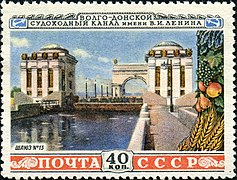
Volga–Don Canal
Lenin Volga–Don Shipping Canal (Russian:Волго-Донской судоходный канал имени, В. И. Ленина, Volga-Donskoy soudokhodniy kanal imeni V. I. Lenina, abbreviated ВДСК, VDSK) is a ship canal in Russia. It connects the Volga and the Don at their closest points. Opened in 1952, its length is 101 km (63 mi), 45 km (28 mi) of which is through rivers and reservoirs.
Volga–Don Canal
63[1] miles (101 km)
141 m (463 ft)[2]
16.8 m (55 ft)[2]
3.6 m (12 ft)[2]
13[3]
144 ft (44 m)
Open
1948
1 June 1952
1952
Tsimlyansk Reservoir, near Volgodonsk, Russia
The canal forms a part of the Unified Deep Water System of European Russia. Together with the lower Volga and the lower Don, the canal provides the shortest navigable connection between the Caspian Sea and the world's oceans via the Sea of Azov, the Black Sea, and the Mediterranean Sea.
Future options[edit]
In the 1980s, construction started on a second canal between the rivers. The new canal, dubbed Volga–Don 2 (Russian: Волго-Дон 2; 48°56′37″N 44°30′25″E / 48.94361°N 44.50694°E) would start from the township of Yerzovka on the Volgograd Reservoir, north (upstream) of the Volga Dam, as opposed to the existing Volga–Don Canal that starts south (downstream) of the dam.[25] This would reduce the number of locks traversed by ships coming from the Volgograd Reservoir, or from other Volga or Kama ports farther north, on their way to the Don. The project was abruptly cancelled to cut expenditure on 1 August 1990, by which time more than 40 percent of its funds had already been spent.[25][26][27] Since then most of the stone and metal in the abandoned canal and locks has been looted.[28]
As of 2007–2008, Russian authorities are considering two options for increasing the throughput of navigable waterways between the Caspian basin and the Black Sea. One option, which reuses the name "Volga–Don 2", is to build a second parallel channel ("second thread") of the Volga–Don Canal, equipped with larger locks 300 metres (980 ft) long. This plan would allow for an increase in the canal's annual cargo throughput from 16.5 million tonnes to 30 million tonnes. The other option, which seems to have more support from Kazakhstan,[29] which would be either canal's major customer, is to build the so-called Eurasia Canal along a more southerly route in the Kuma–Manych Depression, some of which is the much shallower Manych Ship Canal. Requiring less digging than the first option and of little use to traffic to and from the Volga, it would provide a speedier connection between the Caspian and the Sea of Azov. It would also require fewer locks than the Volga–Don, as elevations in the Kuma–Manych Depression are lower.[30]






